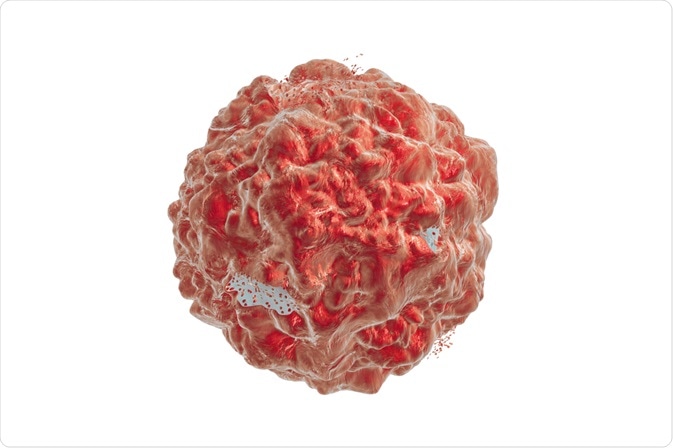Tumor lysis syndrome represents a potentially fatal complication of cancer treatment that is usually seen in patients with rapidly growing, extensive and chemosensitive malignant tumors. This clinical entity is seen as a result of prompt destruction of malignant cells, followed by the instant release of intracellular proteins, ions and metabolites into the extracellular space.
Even though tumor lysis syndrome usually occurs in patients with high-grade hematological malignant diseases, there were reports of cases in a plethora of other hematological malignancies including Hodgkin’s disease, low-grade non-Hodgkin’s lymphoma and fast-growing testicular cancer.
As early recognition of individuals at high risk for acute tumor lysis syndrome enables the early introduction of prophylactic measures that can even prevent fatal outcomes, it is pivotal to accurately identify clinical and laboratory traits, as well as signs and symptoms of this life-threatening condition.

Image Credit: Kateryna Kon / Shutterstock
Etiology and Risk Factors
Tumor lysis syndrome usually follows the treatment of malignancies with cytotoxic therapy, although it can also occur spontaneously in patients with highly proliferative tumors. It is actually considered the most frequent disease-related emergent condition encountered by physicians and specialists caring for children or adults that present with hematologic cancers.
Several factors are known to contribute to the development of tumor lysis syndrome, such as malignancy type, its responsiveness to treatment, rapidity of cell turnover, as well as tumor burden. Other potential risk factors include poor response to hydration, pre-existing renal insufficiency and acute renal failure.
The metabolic abnormalities that are associated with this entity are seen due to massive releases of content and degradation products found in dead tumor cells. More specifically, calcium, potassium, phosphates, urea and uric acid pour into the extracellular space and exceed the filtering capabilities of the kidneys, in turn causing specific metabolic disturbances.
Changes in blood levels of the aforementioned anions, cations and metabolic products can affect the normal functioning of several organs, especially the kidneys, but also the heart, muscles, brain and gastrointestinal tract. Excess phosphorus can have a significant effect on calcium absorption, lowering its levels in the blood.
Clinical Manifestations
The symptomatology of tumor lysis syndrome is non-specific, but commonly observed symptoms include lack of appetite, nausea, vomiting, fatigue, weakness, lethargy and arthralgia. Dark and cloudy urine with reduced urine output can also be seen. Other signs and symptoms that are related to metabolic or electrolyte abnormalities are muscle weakness, seizures, neuromuscular irritability and cardiac arrhythmias. The latter may even result in sudden death in patients with tumor lysis syndrome.
High levels of phosphates and uric acid render patients with this syndrome at particularly high risk for crystal-associated kidney injury, primarily due to the fact that uric acid precipitates easily in the presence of calcium phosphate, whereas calcium phosphate precipitates quickly in the presence of uric acid.
These signs and symptoms are usually followed by specific blood test results, which is a prerequisite for adequate diagnosis. However, the onset may be quite subtle, with hardly any abnormal laboratory values; on the other side of the spectrum, true kidney and organ failure may ensue very quickly.
Management of Tumor Lysis Syndrome
In the management of tumor lysis syndrome, efforts should be made to rectify fluid overload, to avoid dehydration and electrolyte abnormalities, as well as to establish sufficient urinary output before therapy is initiated. Increased levels of potassium and phosphates should be treated swiftly according to standard measures, but the treatment of asymptomatic hypocalcemia is not recommended in a majority of cases.
Aggressive and prompt hydration and increased urination are pivotal steps in the prevention and management of tumor lysis syndrome. Generally speaking, vascular access has to be established, and affected individuals should be hydrated with approximately three liters per m2 every day. In cases when adequate diuresis cannot be achieved only with intravenous hydration, the administration of mannitol (an osmotic diuretic) may be considered.
In addition to adequate hydration, it is essential to administer a hypouricemic agent (either allopurinol or rasburicase) prior to the initiation of treatment. Allopurinol is a powerful inhibitor of xanthine oxidase which can block the conversion of xanthine and hypoxanthine to uric acid.
On the other hand, an alternative approach for inhibiting uric acid formation is to encourage the catabolism of uric acid to allantoin by means of uric acid oxidase. The gene that encodes urate oxidase has been cloned from a fungal species Aspergillus flavus, which allowed the production and subsequent purification of the recombinant enzyme rasburicase.
Bloodwork has to be repeated regularly to assess electrolyte levels and potential kidney damage, but there is also a need to closely monitor urine output and heart rhythm. Future research endeavors should strive to develop a predictive model to identify patients at high risk who would need more aggressive measures, most notably rasburicase or hemodialysis. Hence, it is of utmost importance that research groups continue with the survey of risk factors and outcomes inherent to tumor lysis syndrome.
Further Reading